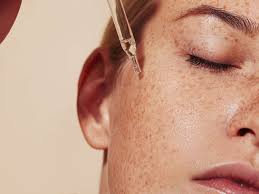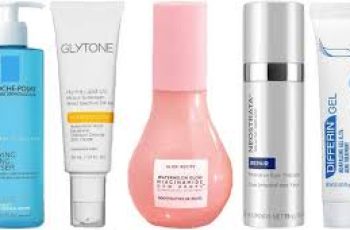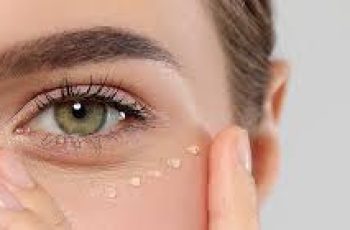Lactobionic Acid Gently Exfoliates Even the Most Sensitive Skin Types
While exfoliation is one of the best ways to remove dead skin cells and enhance your skin’s radiance, many physical and chemical exfoliants can be too harsh in practice, especially if you have sensitive skin. If your complexion seems to react at the sight of acids nearby, but you could still use a little exfoliation, lactobionic acid is a gentler option that might be worth trying. In addition to its exfoliating properties, the ingredient also has benefits like moisturizing and supporting the skin barrier (all with minimal to no irritation). Below, dermatologists explain everything you need to know about lactobionic acid, from its benefits to how to best incorporate it into your daily routine.
Meet the Experts
Hannah Kopelman, MD, is a board-certified dermatologist at Kopelman Cosmetic Surgery in New York City.
Karyn Grossman, MD, is a board-certified dermatologist and cosmetic surgeon at Grossman Dermatology.
What is Lactobionic Acid?
Lactobionic acid is an exfoliating and moisturizing ingredient in skincare that belongs to the polyhydroxy acid (PHA) class. It’s derived from lactose and is known to be gentler on the skin than alpha hydroxy acid (AHA) and beta hydroxy acid (BHA).
“What I find so appealing about lactobionic acid is that it’s so gentle while still delivering real results,” says board-certified dermatologist Hannah Kopelman, MD. “It’s made from lactose, a milk sugar, and that smoothness is what really sets it apart.”
Board-certified dermatologist and cosmetic surgeon Karyn Grossman, MD, explains that lactobionic acid has a larger molecular structure than AHAs and BHAs, allowing it to penetrate deeper into the skin for a gentler exfoliation process.
Benefits of Lactobionic Acid
Are you interested in giving lactobionic acid a try (or do you need a little convincing)? Here are some of the benefits this skincare ingredient can have on your skin:
Gentle Exfoliation: Lactobionic acid exfoliates, helping to remove dead skin cells from the surface of the skin without the harshness of other types of skincare acids. That means it’s less likely to cause irritation, stinging, and burning. “It works by breaking down the bonds between dead skin cells, which encourages cell turnover,” says Kopelman. “This can lead to smoother skin, fewer fine lines, and the healthy glow we all crave.”
Moisturizer: People with dry skin may benefit from incorporating lactobionic acid into their skincare routine because of the ingredient’s hydrating properties. “One of lactobionic acid’s standout properties is its ability to attract and retain moisture,” says Grossman. “It acts as a humectant, drawing water into the skin, improving skin hydration and reducing dryness.”
Antioxidant: Lactobionic acid has antioxidant properties that can protect your skin. 1 “It helps protect your skin from free radicals, which are those nasty molecules that can cause premature aging,” says Kopelman. “By protecting the skin from oxidative stress, lactobionic acid helps maintain a youthful appearance.”
Supports the Skin Barrier: Lactobionic acid helps strengthen the health of the skin barrier. 1 “This is especially beneficial for people with damaged skin, whether due to environmental factors or an underlying condition like eczema or rosacea,” says Kopelman.
Reduces the appearance of fine lines: “By gently exfoliating the skin and improving hydration, lactobionic acid can minimize the appearance of fine lines and wrinkles, making the skin appear smoother and plumper,” says Grossman.
Who Should Use It?
Lactobionic acid is good for many different skin types, but dermatologists say it’s especially good for people with mildly sensitive skin or those who are new to peels and worried about irritating their skin. “It’s a very gentle exfoliant, and even those who can’t tolerate AHAs or BHAs can usually use it without a problem,” says Kopelman. “But really, just about everyone can benefit from lactobionic acid, whether you want to smooth out your skin, give it a little extra moisture, or protect it from signs of aging, which it can also be used for prevention because of lactobionic acid’s hydrating properties.” Grossman tells us it’s great for people with dry or dehydrated skin.
Use with caution if you have a lactose or milk allergy Be careful with lactobionic acid, as it’s derived from lactose. As always, check with your dermatologist if you’re unsure if the ingredient is safe for you.
Application
While lactobionic acid is much gentler than most exfoliants, it’s still important to use it correctly to get the most benefits while taking care of your skin. Here are some top tips:
Let your skin adjust: As with most skincare products, the first rule of thumb is to start slowly. “If you incorporate lactobionic acid into your skincare routine, start by using it two to three times a week, especially if you’re new to exfoliation,” advises Grossman. “This allows your skin to build up a tolerance. As your skin adjusts, you can increase usage to every other day or even daily, depending on how your skin reacts.”
Keep your skin hydrated: After using lactobionic acid, it’s important to use a good moisturizer. “This helps lock in moisture and keep your skin soft,” says Kopelman.
Apply plenty of sunscreen: Keep in mind that exfoliants like lactobionic acid can make your skin more sensitive to the sun, so you need to be careful when applying sunscreen. “Make sure you wear sunscreen every day, even if it’s cloudy,” says Kopelman. “It’s critical to protect your skin from UV rays.”
Stick to evening use: Grossman recommends using lactobionic acid at night, since exfoliants can make your skin more sensitive to the sun.
Watch your routine: Grossman also advises caution when combining lactobionic acid with other strong peels or retinoids. “I generally recommend that you follow up with a retinoid or acid right away. “Take it at night,” Grossman says. “People with very oily skin may be able to tolerate a lactobionic acid tonic followed by a tretinoin, but the dose must be increased very slowly.”
Check for sensitivity: As with other skincare products, you should do a patch test before incorporating lactobionic acid into your skincare routine. This allows you to see how your skin reacts to the product, which is especially important if you have sensitive skin.
Final Verdict
Because lactobionic acid balances exfoliation and moisturizing properties while being gentle on sensitive skin, it may be just the skincare ingredient you never knew you needed. Dermatologists say it works well for most skin types. So if you’re worried about a reaction, you may want to do a patch test, but if you’re looking for a way to achieve rejuvenating results with minimal irritation, it’s a good option.
DQH Knowledge drop: In your 20s, your skin cell turnover decreases. (Cell turnover is a key component in keeping your skin youthful.) You know what else slows down? Your collagen production. Starting in your 20s, collagen decreases by about 1 percent per year. Should you want to prevent fine lines and wrinkles, start by eliminating behaviors that contribute to premature aging. “If it’s bad for you, it’s bad for your skin,” says dermatologist Michel Somenek.
“Cigarette smoking reduces blood flow to the skin and causes premature wrinkling and a dull skin texture. Making the repeated pursed motion to inhale can also cause smoker’s lines. Alcohol and recreational drugs are toxins for the skin that damage its cellular structure and DNA,” Somenek tells us. “The faster you eliminate vices while you are young, the better chance your skin and body have to recuperate.” Also, adopting an anti-aging routine in your 20s is key. After all, the best offense is a good defense. We spoke to Somenek and experts Joshua Ross and Audrey Kunin to find out more.
Keep reading for the best anti-aging products for your 20s, according to skincare professionals.
Sunscreen
“We all know that the sun is the number one cause of skin aging and starting the prevention in your 20s is very important,” Ross says. “The majority of your sun damage won’t start to appear until you’re in your 30s, so don’t wait until you see it surface or you’ll be behind the curve. Stay ahead of it with a good-quality zinc-based sunscreen worn daily.”
Farmacy Green Defense Daily Mineral Sunscreen
An invisible sunscreen with SPF 30, plus botanical extracts meant to protect skin with tons of antioxidants. Bonus: It’s clean and fine to use under makeup.
Bareminerals Complexion Rescue™ Tinted Moisturizer Broad Spectrum SPF 30
Although we recommend you use your SPF and moisturizer separately, we also understand moments when you don’t have time or energy for that extra step. For those times, this bareMinerals moisturizer is a great thing to have on hand.
Vitamin C Serum
“A great introduction to anti-aging is to start with a vitamin C serum in your morning skincare routine,” Ross says. “It’s a powerful antioxidant that will neutralize free radicals and brighten the skin.” He adds that it’s a great way to counteract the effects of the sun’s harmful rays, which, as previously mentioned, are among the biggest causes of premature aging.
Drunk Elephant C-Firma™ Vitamin C Day Serum
The Drunk Elephant C-Firma is a lightweight serum that promises to give skin a glow by combining the brightening powers of vitamin C with ferulic acid, l-ascorbic acid, and vitamin E. The included sodium hyaluronate is meant to replace hydration loss, so you shouldn’t have to deal with any irritation.
Sunday Riley C.E.O. Rapid Flash Brightening Serum
This potent serum is jam-packed with vitamin C (15 percent, to be exact), which means it’s a potential superstar at both brightening skin and dousing it in antioxidants.
Peptides
Using peptides on your skin has many benefits, says Somenek. “The skin barrier is what defends the body against pollution, UV rays, bacteria, and toxins. It can be damaged by several everyday factors. Using topical peptides aids in building a stronger barrier,” he says. “Peptides comprise elastic fibers, which are a type of protein. These fibers help to make skin appear taut and firm. Peptides can also help repair damaged skin, relieve inflammation, and even out skin tone. Some peptides can kill acne-causing bacteria that is common in 20-somethings.”
Kunin agrees, saying, “Peptides are an excellent entry point for supporting collagen.” She recommends looking for face and eye treatments that contain these collagen-boosting powerhouses.
Charlotte Tilbury Magic Eye Rescue Cream
This Charlotte Tilbury super-emollient eye cream has a base of coconut oil and shea butter (read: it’s incredibly hydrating). Botanicals plus peptides are meant to help reduce dark circles and boost collagen, respectively.
This creamy moisturizer serves up potent collagen-boosting peptides and pycnogenol, and antioxidant-rich vitamin C. “Instead of sitting on top of the skin, peptides penetrate the outer layer so they go deep. The ‘signals’ they send tell the cells to produce elastin and collagen, which are needed for youthful-looking skin,” explains Somenek.
At-Home Peel Pads
Remember that skin cell turnover fiasco we talked about earlier? One way to help support it is by exfoliating. “Exfoliation is important to help keep skin fresh and luminous,” Kunin says. She recommends using at-home peel pads as an easy and effective way to exfoliate.
“The goal in your 20s is to fight the slowing pace of cell turnover. It is wise to use products that gently exfoliate, yet still remove oil and other impurities. Products that have Alpha Hydroxy Acids (AHA) or Beta Hydroxy Acids (BHA) are a good choice.”
According to Somenek, you should only exfoliate two to three times a week. “People of all ages are guilty of over-exfoliating and that can be too much of a good thing,” he says.
Dermadoctor Kakadu C Intensive Vitamin C Peel Pad
A few swipes of this Derma Doctor powerful peel pad promise to leave your skin glowing and smooth, thanks to the seven (yes, seven) types of chemical exfoliants, including AHA and BHA. It also contains vitamin C via Kakadu plum extract for added brightening and antioxidant protection.
KEY INGREDIENTS Kakadu plum extract is sourced from the Kakadu plum, a fruit grown in northern Australia. It contains vitamin C, which restores the skin’s natural barrier, increases collagen production, and soothes irritation.
Dr. Dennis Gross Skincare Alpha Beta® Universal Daily Peel Pads
These are the gold standard of peel pads, with a cult following and over 900 five-star reviews on Sephora. They’re easy to use and contain a blend of anti-aging exfoliating acids.
Emollient Night Cream
“In your 20s, you need to start upping the hydration in your skincare routine. You may have been cautious of over-moisturizing because of acne in your teens, but as you enter your 20s, your skin transitions and becomes drier,” Ross says. “I recommend an emollient night cream added into your evening skincare regimen.”
“Twenty-somethings need to make sure that they are not using creams that will clog their pores and cause excess oil production,” says Somenek. Opt for non-comedogenic products.
Cerave Skin Renewing Night Cream
One great choice is the CeraVe Skin Renewing Night Cream, which is a non-comedogenic night cream that leaves skin soft and glowy. It combines the moisturizing powers of ceramides and hyaluronic acid.
RoC Retinol Correxion Max Hydration Creme
“The best night cream ingredients contain retinol, benzoyl peroxide, and/or salicylic acid or hyaluronic acid. The goal is to moisturize, yet remove excess oil,” says Somenek. This Roc Retinol Correxion cream fits the bill as it contains both hyaluronic acid and retinol so it promises to moisturize while also being non-comedogenic.



